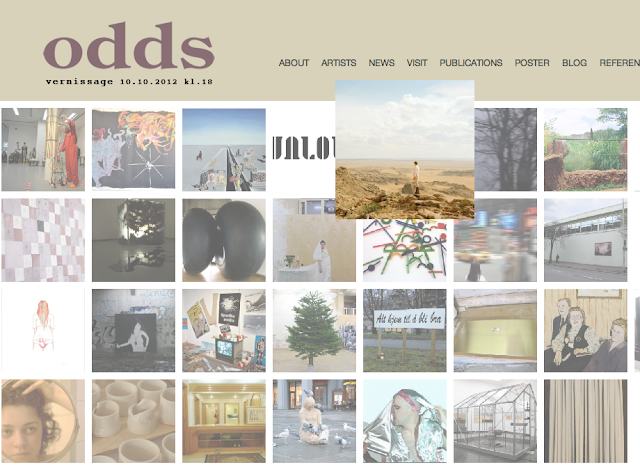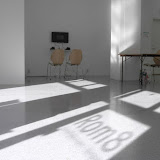ABOUT TIME / in Room 8 / 20th of Nov 2012 /Anne Marthe Dyvi
Starting point/ a small excerpt from Wikipedia first:
‹‹ Two distinct viewpoints on time divide many prominent philosophers. One view is that time is part of the fundamental structure of the universe, a dimension in which events occur in sequence. Sir Isaac Newton subscribed to this realist view, and hence it is sometimes referred to as Newtonian time.[21] An opposing view is that time does not refer to any kind of actually existing dimension that events and objects "move through", nor to any entity that "flows", but that it is instead an intellectual concept (together with space and number) that enables humans to sequence and compare events[43] This second view, in the tradition of Gottfried Leibniz[15] and Immanuel Kant,[22][23] holds that space and time "do not exist in and of themselves, but ... are the product of the way we represent things", because we can know objects only as they appear to us.››
(Wikipedia, http://en.wikipedia.org/wiki/Time)
My personal view on art, time and artistic research/ a hypothesis
Everything that physically exists is that which highlights time, in the same way that clothes on the clothes line reveal the wind. Time is not observable or existent without this. This is what I can, at this time, say that time is; therefore only able to explain it by its surrounding phenomena.
Our physical decay, our breath, our actions and movements are what make time exist; the surrounding is its level of existence. The artist observes this phenomenon, indirectly and without being conscious of it, then tansforms these observations and time data to be made manifest in art. Like the act of taking something out of reality, putting it in a Petri dish under a microscope, categorizing it and preserving it.
So for the first time, I have realized the reason for the existence of the term 'artistic research', but it was not what I thought it was: that artistic research is the art that artists make, display and write about. No, artistic research or the making of art is actually research on TIME, artists demonstrating time through research. Artists can depict time, detach it from its original location or logic, and enable an abstract interpretation. You find it in visual art, in literature, in music, theatre and dance.
But all this research, and I naturally want to say, art, prove that time is a personally experienced phenomenon. In two ways: there are many artists who do a lot of work where time is observable. So therefore; many results create a wealth of information, experiences, and expressions, mediated through the artist. There is a huge body of material, and when they relate to the same research field, the results affect each other. The fact that it is a personal or experiential phenomenon, is proved only indirectly by artists: it is the artist's peer review, namely the viewer that interprets research results within him or herself, by experiencing the art. The viewers then get their resonance or dissonance from the artwork, namely the artists evidence / research material on time.
This large group of appraisers and material manufacturers don’t work with the hierarchical structure that the university sector is based within. Sure, there is a hierarchy in the arts as well, but this is around the art work (possibilities, power, money, networks and so on). Art not including the power structures around it cannot build brick by brick, research refers to research, and there are so many voices contributing that they create a cacophony.
The concept cacophony is often used to critique music if it is perceived as complicated and dissonant, or to describe many voices making sound simultaneously, preventing the transmission of messages or sense.
Perhaps he fact that the results are cacophonous can help us to identify and formulate time’s own character. As a Lime tree repeats its own form in the shape of its leaf, tree and leaf are similar. It may be that the methodology of scientific time research, known to us as art or artistic research, can say something about time itself. So if seen as a whole the research results constitute a cacophony.
Time says this to us:
“I am in transitions - I am observable, or in a mode of existence when the transition occurs, when a snowflake goes from snow to water on the palm of your hand, I'm there. But like anything emulated, I cannot be without the other, without physics. Maybe I am a by-product of processes, such as friction creates friction, but heat as well. Or maybe I am the motivation of the processes, they happen to generate me, Time.”
Unfortunately, TIME also reminds us that it is our self that hinders our ability to grasp TIME. We resonate time in a physical way, but strive to create a language around our experiences. For we are only mediums with the limitations that this gives. Like a radio is unable to transfer images, we struggle to comprehend time. To be able to experience time at the same time that we view it from a distance. We have such difficulty to be in two times simultaneously. Experiencing and interpreting simultaneously. Ultimately we want to be at ease with time. We know who you are; you cannot make us feel troubled, Mr Time. Therefore, we use art as a research park on time, to cope with this turmoil. Then it will be in art itself that we can hold time down, to study it through a personal microscope. For the benefit of the formation of self and the formation of culture.
But if we look at research as a place for development, or evolution as a refining process, where will this art or time research bring us, when the methodology and the transfer of results are so scattered? Seemingly without a clear goal. Will we succeed in time research within art, to fully grasp time? Or put another way, will we get an answer on what time is through art? If so, will the case of art research change from time to something else? And if so, what?
If we get answers, the methodology of the research is proven to be adequate, and the model might be preserved. The research lifts us to a higher level of enlightenment, the time after the defining or discovery of time. What the next case will be in the arts I am also probably not able to describe, as I have not reached enlightenment enough. If we don’t reach enlightenment through art, we will probably just keep on researching the answer to what TIME is. The answer then is that keeping up this activity is being as close to understanding time as possible. Or that we as mediums are not able to develop our selves to receive time. Experience tells us that we will continue to develop, unless it is the case that to grasp time is contrary to our evolution, but then I can not know that either. Maybe we have a built-in default that prevents us from fully grasping time, since to do so might bring about our end.
Or maybe time is merely a relationship, or a glue. The glue in the collage. Information and time fail to conclude.

















































